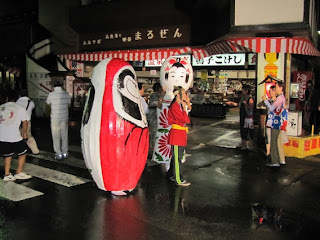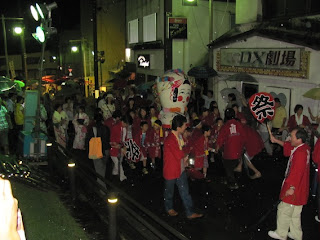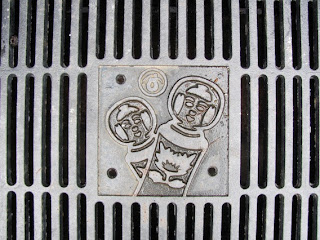 |
| Yes, rain boots were necessary. |
My my, how time does fly. I really should have done part 2 of the National Kokeshi Festival weeks ago. Oh well, better late than never.
Naruko Onsen 鳴子温泉 is a quintessential onsen/kokeshi town, and this is important since the origin of kokeshis is intimately connected with onsens. There are currently 25 traditional kokeshi makers in Naruko, and all -- yes all -- of the souvenier shops in the town sell kokeshis of some sort. Of courses the town smells like sulpher, an odor I have come to pleasantly associate with onsens. And yes there are signs of kokeshis absolutely everywhere. Naruko is truly kokeshi-land, and in that sense it is fairly unique compared to some other places we've visited.
The main festival's purpose appeared to be three-fold: 1) Display the best works from around Tohoku in the competition portion, 2) sell kokeshis and kokeshi-related items, and 3) promote the tradition of kokeshi making. All three were well-worth seeing.
As for the display of award-winning kokeshis, it was fantastic, showcasing the artistry and craftsmanship of Japan's kokeshi makers. I can't recommend enough going to a event like this simply to see the tradtional world of kokeshis in all its amazing variety. Interestingly, the more I learn about these dolls not only can I pick out the different types more readily, but I also can recognize the different artists works by the kokeshi faces. This has been something of a surprise to me.
Now, one of my maxims as a kokeshi enthusiast is that one cannot simply look at kokeshis: One must purchase them as well since it supports the craftsmen and the art. It also ensures that you have them for display in your home, and kokeshis are surprisingly useful for adding a bit of color pretty much anywhere there's space for a wooden cylinder. For instance, on top of a desk, next to the computer, on a bookshelf with the books, on the piano, wherever. The kokeshis aren't picky and neither am I. And believe me, they are a constant delight to look at and always pique the interest of guests. Having said all of that, of course we bought a lot of kokeshis at the festival.
 |
| The main concourse. Slippers only. |
The third part of the festival was promotion of the art, and as this was the 57th anniversary of the event the kokeshi makers know perfectly well how to do this. For instance, the center walkway -- right in the middle of the Naruko High School gym -- was turned into a traditional Japanese shop-front area with elevated seating for the kokeshi makers who were there to talk with attendees. As mentioned in other posts, getting to meet the artists has always been a highlight of every kokeshi adventure we've had. There was also an area for people to make their own kokeshis for 800 yen, under the guidance of a pro of course. The coolest thing at the festival may very well have been watching the traditional foot-powered lathe which was demonstrated by an old kokeshi maker whose name eludes me. Everyone there was amazed to see him turn out perfectly smooth, beautiful kokeshis that looked no different than dolls made on an electric lathe. If I hadn't seen I wouldn't have believed it.
This was day one, and we spent hours wandering around and chatting with fellow enthusiasts and craftsmen, and just enjoying the atmosphere in an event devoted solely to the world of traditional kokeshis. Looking around Naruko town was also treat, as was the outdoor festival, and day two as well, all of which I'll discuss in the next couple of blog entries.
 |
| Kokeshi-making demonstration. Even kids like this stuff. |
 |
| These cool Tsuchiyu 土湯系"takobozu" たこぼうず were for sale, but weren't cheap. |
 |
| The make-your-own kokeshi area. |
 |
| Some very nice Naruko kokeshis. If you look closely at the bottom you'll notice the Japanese "Traditional Arts" sticker on the bottom, which is unusual among kokeshis. I've seen those on various Japanese handicrafts, but never before on kokeshis. |
 |
| Back before there were electric lathes there were foot-powered lathes. It really is possible to make a kokeshi with this thing, but it takes a long time. |
 |
| Mr. Ogasawara Yoshio 小笠原義雄 from Sendai City, who makes Togatta 遠刈田系 kokeshis. |
 |
| Mr. Sasamori Junichi 笹森淳一from Hirosaki in Aomori Prefecture. His Tsugaru kokeshis are truly exquisite, and they sold out fast. |
 |
| Kokeshi art on linen. We bought one of these and will probably frame it. |
 |
| Tsuchiyu kokeshis Onsen. I really like these for some reason. |
 |
| Another delightful kokeshi face. |
 |
| Winning kokeshis at this year's event. Not for sale. |
 |
| Another view. |











































